
February 10 2024 Prelims Practice Questions (PPQs)
Subscribe to Never Miss an Important Update! Assured Discounts on New Products!
Must Join PMF IAS Telegram Channel & PMF IAS History Telegram Channel
- These Prelims Practice Questions (PPQs) are based on PMF IAS Daily Current Affairs.
- The daily current affairs are uploaded every day by 8 PM. You can read the Daily Current Affairs from here.
- Subscribers of the “Current Affairs” course can Download Daily Current Affairs in PDF/DOC from here.
[Quiz] Daily Prelims Practice Questions (PPQs) – February 10 2024
0 of 9 questions completed
Questions:
- 1
- 2
- 3
- 4
- 5
- 6
- 7
- 8
- 9
Information
These MCQs are based on PMF IAS Daily Current Affairs. The daily current affairs are uploaded every day by 8 PM. You can read the Daily Current Affairs from here. Subscribers of the “Current Affairs” course can Download Daily Current Affairs in PDF/DOC from here.
You have already completed the Test before. Hence you can not start it again.
Test is loading...
You must sign in or sign up to start the Test.
You have to finish following quiz, to start this Test:
Your results are here!! for" [Quiz] Daily Prelims Practice Questions (PPQs) – February 10 2024 "
0 of 9 questions answered correctly
Your time:
Time has elapsed
Your Final Score is : 0
You have attempted : 0
Number of Correct Questions : 0 and scored 0
Number of Incorrect Questions : 0 and Negative marks 0
| Average score |
|
| Your score |
|
-
Not categorized
You have attempted: 0
Number of Correct Questions: 0 and scored 0
Number of Incorrect Questions: 0 and Negative marks 0
| Pos. | Name | Entered on | Points | Result |
|---|---|---|---|---|
| Table is loading | ||||
| No data available | ||||
- 1
- 2
- 3
- 4
- 5
- 6
- 7
- 8
- 9
- Answered
- Review
-
Question 1 of 9
1. Question
Q1. {Envi – Pollution} Consider the following statements with respect to the Atmospheric Ammonia:
- It is the most abundant alkaline gas in the atmosphere.
- Excess nitrogen can lead to species composition changes and other deleterious effects.
- The industrial pollution is the largest source of anthropogenic ammonia emissions.
How many of the above statement(s) is/are incorrect?
Correct
Explanation
Statement 1 is correct
- Atmospheric ammonia (NH3) is a major component of the nitrogen cycle and the most abundant alkaline gas in the atmosphere.
- It’s a key component of the ecosystem and global nitrogen cycle, and it contributes to the formation of secondary particles.
- Atmospheric ammonia is an environmental pollutant that affects ecosystems across the planet.
- It originates from both natural and anthropogenic sources.
Statement 2 is correct
- Excess nitrogen can cause eutrophication and acidification effects on semi-natural ecosystems, which in turn can lead to species composition changes and other deleterious effects.
Statement 3 is incorrect
- Around 51-60% of anthropogenic ammonia emissions can be traced back to crop cultivation, and about half of these emissions are associated with three main staple crops: rice, wheat and maize.
- The effective management of fertilizer in the growing of rice could lead to reduction of lower atmospheric ammonia emissions.
Answer: (a) Only one; Difficulty Level: Medium
Incorrect
Explanation
Statement 1 is correct
- Atmospheric ammonia (NH3) is a major component of the nitrogen cycle and the most abundant alkaline gas in the atmosphere.
- It’s a key component of the ecosystem and global nitrogen cycle, and it contributes to the formation of secondary particles.
- Atmospheric ammonia is an environmental pollutant that affects ecosystems across the planet.
- It originates from both natural and anthropogenic sources.
Statement 2 is correct
- Excess nitrogen can cause eutrophication and acidification effects on semi-natural ecosystems, which in turn can lead to species composition changes and other deleterious effects.
Statement 3 is incorrect
- Around 51-60% of anthropogenic ammonia emissions can be traced back to crop cultivation, and about half of these emissions are associated with three main staple crops: rice, wheat and maize.
- The effective management of fertilizer in the growing of rice could lead to reduction of lower atmospheric ammonia emissions.
Answer: (a) Only one; Difficulty Level: Medium
Unattempted
Explanation
Statement 1 is correct
- Atmospheric ammonia (NH3) is a major component of the nitrogen cycle and the most abundant alkaline gas in the atmosphere.
- It’s a key component of the ecosystem and global nitrogen cycle, and it contributes to the formation of secondary particles.
- Atmospheric ammonia is an environmental pollutant that affects ecosystems across the planet.
- It originates from both natural and anthropogenic sources.
Statement 2 is correct
- Excess nitrogen can cause eutrophication and acidification effects on semi-natural ecosystems, which in turn can lead to species composition changes and other deleterious effects.
Statement 3 is incorrect
- Around 51-60% of anthropogenic ammonia emissions can be traced back to crop cultivation, and about half of these emissions are associated with three main staple crops: rice, wheat and maize.
- The effective management of fertilizer in the growing of rice could lead to reduction of lower atmospheric ammonia emissions.
Answer: (a) Only one; Difficulty Level: Medium
-
Question 2 of 9
2. Question
Q2. {Sci – Bio – Disease} Consider the following statements with respect to Monkey Fever:
- It is also known as Kyasanur Forest Disease (KFD).
- It is a viral disease with ticks being the transmitter of the disease.
- The Indian Council of Medical Research has indigenously developed a vaccine for this disease recently.
How many of the above statement(s) is/are correct?
Correct
Explanation
Statement 1 is correct
- Monkey Fever was first noticed in the Kysanur Forest area of Sorab Taluk in Shivamogga district in 1956 and was named after the region.
- It is also known as Kyasanur Forest Disease (KFD).
Statement 2 is correct
- The disease spreads through ticks.
- The monkey also gets affected by the disease and the death of a monkey serves as a warning of a KFD outbreak.
- Primates that come in contact with infective ticks contract the disease.
- Human beings who visit the forest area either for livelihood, to graze cattle, or to collect firewood contract the disease.
- A blood test is done to identify if someone has KFD.
- Normally, the transmission begins from late November to June.
- It peaks between December and March.
Statement 3 is incorrect
- There is no specific treatment, doctors handle the symptoms and monitor the vitals daily.
- Currently there is no vaccination for the disease.
- An attempt to use a vaccine was given up after studies showed it to be ineffective.
- The ICMR is said to be in consultation with Indian Immunologicals Ltd. for development of a vaccine.
Answer: (b) 1 and 2; Difficulty Level: Medium
Incorrect
Explanation
Statement 1 is correct
- Monkey Fever was first noticed in the Kysanur Forest area of Sorab Taluk in Shivamogga district in 1956 and was named after the region.
- It is also known as Kyasanur Forest Disease (KFD).
Statement 2 is correct
- The disease spreads through ticks.
- The monkey also gets affected by the disease and the death of a monkey serves as a warning of a KFD outbreak.
- Primates that come in contact with infective ticks contract the disease.
- Human beings who visit the forest area either for livelihood, to graze cattle, or to collect firewood contract the disease.
- A blood test is done to identify if someone has KFD.
- Normally, the transmission begins from late November to June.
- It peaks between December and March.
Statement 3 is incorrect
- There is no specific treatment, doctors handle the symptoms and monitor the vitals daily.
- Currently there is no vaccination for the disease.
- An attempt to use a vaccine was given up after studies showed it to be ineffective.
- The ICMR is said to be in consultation with Indian Immunologicals Ltd. for development of a vaccine.
Answer: (b) 1 and 2; Difficulty Level: Medium
Unattempted
Explanation
Statement 1 is correct
- Monkey Fever was first noticed in the Kysanur Forest area of Sorab Taluk in Shivamogga district in 1956 and was named after the region.
- It is also known as Kyasanur Forest Disease (KFD).
Statement 2 is correct
- The disease spreads through ticks.
- The monkey also gets affected by the disease and the death of a monkey serves as a warning of a KFD outbreak.
- Primates that come in contact with infective ticks contract the disease.
- Human beings who visit the forest area either for livelihood, to graze cattle, or to collect firewood contract the disease.
- A blood test is done to identify if someone has KFD.
- Normally, the transmission begins from late November to June.
- It peaks between December and March.
Statement 3 is incorrect
- There is no specific treatment, doctors handle the symptoms and monitor the vitals daily.
- Currently there is no vaccination for the disease.
- An attempt to use a vaccine was given up after studies showed it to be ineffective.
- The ICMR is said to be in consultation with Indian Immunologicals Ltd. for development of a vaccine.
Answer: (b) 1 and 2; Difficulty Level: Medium
-
Question 3 of 9
3. Question
Q3. {Prelims – Agri – Crops} Consider the following statements with respect to Nematode:
- They are microscopic worms that damage the agricultural crops.
- They are highly capable of surviving in any environment.
- Steinernema is a family of nematode that are harmful to humans.
Which of the above statement is/are correct?
Correct
Explanation
Statement 1 is incorrect
- Nematodes are microscopic, worm-like animals that are part of the phylum Nematoda.
- Nematodes could control crop pests in warm, humid places and helps to grow agricultural crops.
Statement 2 is correct
- Nematodes are among the most abundant animals on Earth.
- They occur as parasites in animals and plants or as free-living forms in soil, fresh water, marine environments, and even such unusual places as vinegar, beer malts, and water-filled cracks deep within Earth’s crust.
- Nematodes have been reported from every continent on earth and occur in deserts, swamps, the oceans, the tropics and Antarctica.
- Nematode parasites of animals occur in almost all organs of the body, but the most common sites are in the alimentary, circulatory, and respiratory systems.
- Some of these worms are known by such common names as hookworm, lungworm, pinworm and threadworm.
Statement 3 is incorrect
- Key facts about Steinernema Adamsi:
- This new species is a member of a family of nematodes called Steinernema that have long been used in agriculture to control insect parasites without pesticides.
- Steinernema are not harmful to humans or other mammals and were first discovered in the 1920s.
- This new species is part of a special group of nematodes considered beneficial to humans because it can infect and kill insect pests
- It is an entomopathogenic nematode that crawls inside of an insect, defecates highly pathogenic bacteria into its blood and then combines with that bacterium to kill the insect host.

Answer: (a) Only one; Difficulty Level: Medium
Incorrect
Explanation
Statement 1 is incorrect
- Nematodes are microscopic, worm-like animals that are part of the phylum Nematoda.
- Nematodes could control crop pests in warm, humid places and helps to grow agricultural crops.
Statement 2 is correct
- Nematodes are among the most abundant animals on Earth.
- They occur as parasites in animals and plants or as free-living forms in soil, fresh water, marine environments, and even such unusual places as vinegar, beer malts, and water-filled cracks deep within Earth’s crust.
- Nematodes have been reported from every continent on earth and occur in deserts, swamps, the oceans, the tropics and Antarctica.
- Nematode parasites of animals occur in almost all organs of the body, but the most common sites are in the alimentary, circulatory, and respiratory systems.
- Some of these worms are known by such common names as hookworm, lungworm, pinworm and threadworm.
Statement 3 is incorrect
- Key facts about Steinernema Adamsi:
- This new species is a member of a family of nematodes called Steinernema that have long been used in agriculture to control insect parasites without pesticides.
- Steinernema are not harmful to humans or other mammals and were first discovered in the 1920s.
- This new species is part of a special group of nematodes considered beneficial to humans because it can infect and kill insect pests
- It is an entomopathogenic nematode that crawls inside of an insect, defecates highly pathogenic bacteria into its blood and then combines with that bacterium to kill the insect host.

Answer: (a) Only one; Difficulty Level: Medium
Unattempted
Explanation
Statement 1 is incorrect
- Nematodes are microscopic, worm-like animals that are part of the phylum Nematoda.
- Nematodes could control crop pests in warm, humid places and helps to grow agricultural crops.
Statement 2 is correct
- Nematodes are among the most abundant animals on Earth.
- They occur as parasites in animals and plants or as free-living forms in soil, fresh water, marine environments, and even such unusual places as vinegar, beer malts, and water-filled cracks deep within Earth’s crust.
- Nematodes have been reported from every continent on earth and occur in deserts, swamps, the oceans, the tropics and Antarctica.
- Nematode parasites of animals occur in almost all organs of the body, but the most common sites are in the alimentary, circulatory, and respiratory systems.
- Some of these worms are known by such common names as hookworm, lungworm, pinworm and threadworm.
Statement 3 is incorrect
- Key facts about Steinernema Adamsi:
- This new species is a member of a family of nematodes called Steinernema that have long been used in agriculture to control insect parasites without pesticides.
- Steinernema are not harmful to humans or other mammals and were first discovered in the 1920s.
- This new species is part of a special group of nematodes considered beneficial to humans because it can infect and kill insect pests
- It is an entomopathogenic nematode that crawls inside of an insect, defecates highly pathogenic bacteria into its blood and then combines with that bacterium to kill the insect host.

Answer: (a) Only one; Difficulty Level: Medium
-
Question 4 of 9
4. Question
Q4. {MoFAH – Schemes} Consider the following statements with respect to Pradhan Mantri Matsya Kisan Samridhi Sah-Yojana (PM-MKSSY):
- It is a centrally sponsored scheme to facilitate access to institutional financing fisheries sector micro and small enterprises.
- It provides one-time incentive to beneficiaries for purchasing aquaculture insurance.
- Identification of targeted beneficiaries relies on the sole discretion of Department of Fisheries.
Which of the above statement(s) is/are incorrect?
Correct
Explanation
Statement 1 is incorrect
- The Union Cabinet chaired by Prime Minister Shri Narendra Modi approved the “Pradhan Mantri Matsya Kisan Samridhi Sah-Yojana (PM-MKSSY)”, a Central Sector Sub-scheme under the Pradhan Mantri Matsya Sampada for formalization of the fisheries sector and supporting fisheries micro and small enterprises with an investment of over Rs. 6,000 crores over a period of next four (4) years from FY 2023-24 to FY 2026-27 in all States/Union Territories.
- The Sub-scheme will be implemented as a Central Sector Sub-scheme under the Central Sector Component of the PMMSY at an estimated outlay of Rs.6,000 crore consisting of 50% i.e. Rs.3,000 crore public finance including the World Bank and the AFD external financing, and rest 50% i.e.Rs.3,000 crore being the anticipated investment from the beneficiaries/private sector leverage.
Statement 2 is correct
- Aims and objectives of PM-MKSSY:
- Gradual Formalization of the unorganized fisheries sector through self-registration of fishers, fish farmers and supportive workers under a National Fisheries Sector Digital Platform including creation of work based digital identifies of fish workers for improved service delivery.
- Facilitating access to institutional financing fisheries sector micro and small enterprises.
- Providing one-time incentive to beneficiaries for purchasing aquaculture insurance.
- lncentivizing fisheries and aquaculture microenterprises through performance grants for improving fisheries sector value-chain efficiencies including creation and maintenance of jobs.
Statement 3 is correct
- Intended Beneficiaries:
- Fishers, Fish (Aquaculture) Farmers, Fish workers, Fish Vendors or such other person directly engaged in fisheries value chain.
- Micro and Small enterprises in the form of Proprietary Firms, Partnership Firms and Companies registered in India, Societies, Limited Liability Partnerships (LLPs), Cooperatives, Federations, Village Level Organizations like Self Help Groups (SHGs), Fish Farmers Producer Organizations (FFPOs) and Startups engaged in fisheries and aquaculture value chains.
- FFPOs also include Farmers Producer Organizations (FPOs).
- Any other beneficiaries that may be included by the Department of Fisheries, Gol as targeted beneficiaries.
Answer: (a) Only one; Difficulty Level: Medium
Incorrect
Explanation
Statement 1 is incorrect
- The Union Cabinet chaired by Prime Minister Shri Narendra Modi approved the “Pradhan Mantri Matsya Kisan Samridhi Sah-Yojana (PM-MKSSY)”, a Central Sector Sub-scheme under the Pradhan Mantri Matsya Sampada for formalization of the fisheries sector and supporting fisheries micro and small enterprises with an investment of over Rs. 6,000 crores over a period of next four (4) years from FY 2023-24 to FY 2026-27 in all States/Union Territories.
- The Sub-scheme will be implemented as a Central Sector Sub-scheme under the Central Sector Component of the PMMSY at an estimated outlay of Rs.6,000 crore consisting of 50% i.e. Rs.3,000 crore public finance including the World Bank and the AFD external financing, and rest 50% i.e.Rs.3,000 crore being the anticipated investment from the beneficiaries/private sector leverage.
Statement 2 is correct
- Aims and objectives of PM-MKSSY:
- Gradual Formalization of the unorganized fisheries sector through self-registration of fishers, fish farmers and supportive workers under a National Fisheries Sector Digital Platform including creation of work based digital identifies of fish workers for improved service delivery.
- Facilitating access to institutional financing fisheries sector micro and small enterprises.
- Providing one-time incentive to beneficiaries for purchasing aquaculture insurance.
- lncentivizing fisheries and aquaculture microenterprises through performance grants for improving fisheries sector value-chain efficiencies including creation and maintenance of jobs.
Statement 3 is correct
- Intended Beneficiaries:
- Fishers, Fish (Aquaculture) Farmers, Fish workers, Fish Vendors or such other person directly engaged in fisheries value chain.
- Micro and Small enterprises in the form of Proprietary Firms, Partnership Firms and Companies registered in India, Societies, Limited Liability Partnerships (LLPs), Cooperatives, Federations, Village Level Organizations like Self Help Groups (SHGs), Fish Farmers Producer Organizations (FFPOs) and Startups engaged in fisheries and aquaculture value chains.
- FFPOs also include Farmers Producer Organizations (FPOs).
- Any other beneficiaries that may be included by the Department of Fisheries, Gol as targeted beneficiaries.
Answer: (a) Only one; Difficulty Level: Medium
Unattempted
Explanation
Statement 1 is incorrect
- The Union Cabinet chaired by Prime Minister Shri Narendra Modi approved the “Pradhan Mantri Matsya Kisan Samridhi Sah-Yojana (PM-MKSSY)”, a Central Sector Sub-scheme under the Pradhan Mantri Matsya Sampada for formalization of the fisheries sector and supporting fisheries micro and small enterprises with an investment of over Rs. 6,000 crores over a period of next four (4) years from FY 2023-24 to FY 2026-27 in all States/Union Territories.
- The Sub-scheme will be implemented as a Central Sector Sub-scheme under the Central Sector Component of the PMMSY at an estimated outlay of Rs.6,000 crore consisting of 50% i.e. Rs.3,000 crore public finance including the World Bank and the AFD external financing, and rest 50% i.e.Rs.3,000 crore being the anticipated investment from the beneficiaries/private sector leverage.
Statement 2 is correct
- Aims and objectives of PM-MKSSY:
- Gradual Formalization of the unorganized fisheries sector through self-registration of fishers, fish farmers and supportive workers under a National Fisheries Sector Digital Platform including creation of work based digital identifies of fish workers for improved service delivery.
- Facilitating access to institutional financing fisheries sector micro and small enterprises.
- Providing one-time incentive to beneficiaries for purchasing aquaculture insurance.
- lncentivizing fisheries and aquaculture microenterprises through performance grants for improving fisheries sector value-chain efficiencies including creation and maintenance of jobs.
Statement 3 is correct
- Intended Beneficiaries:
- Fishers, Fish (Aquaculture) Farmers, Fish workers, Fish Vendors or such other person directly engaged in fisheries value chain.
- Micro and Small enterprises in the form of Proprietary Firms, Partnership Firms and Companies registered in India, Societies, Limited Liability Partnerships (LLPs), Cooperatives, Federations, Village Level Organizations like Self Help Groups (SHGs), Fish Farmers Producer Organizations (FFPOs) and Startups engaged in fisheries and aquaculture value chains.
- FFPOs also include Farmers Producer Organizations (FPOs).
- Any other beneficiaries that may be included by the Department of Fisheries, Gol as targeted beneficiaries.
Answer: (a) Only one; Difficulty Level: Medium
-
Question 5 of 9
5. Question
Q5. {Governance – Initiatives} Consider the following statements about Electoral Trusts:
- They are interest-free bearer instruments to donate money to political parties that was announced in the 2017 Union Budget.
- It can be formed by any company registered under Section 25 of the Companies Act, 1956.
- Electoral Trusts must donate 95% of contributions received in a financial year to political parties.
- Like Electoral Bonds, Electoral Trusts are also exempt from disclosure requirements.
How many of the above statement(s) is/are correct?
Correct
Explanation
Statement 1 is incorrect
- An Electoral Trust is a trust set up by companies to distribute contributions received from other companies and individuals to political parties.
- The Electoral Trusts Scheme was introduced by the UPA government in 2013.
- The scheme was meant to facilitate donations to political parties by corporates and individuals.
Statement 2 is correct
- Any company registered under Section 25 of the Companies Act, 1956, can form an electoral trust.
- Under the Income Tax Act, 1961 the donation to the electoral trust can be provided by the following:
- Any citizen of India,
- A company registered in India or a firm,
- Hindu Undivided Family and
- Association of persons living in India.
Statement 3 is correct
- The electoral trusts have to apply for renewal every 3 financial years.
- They must donate 95% of contributions received in a financial year to political parties registered under the Representation of the People Act, 1951.
Statement 4 is incorrect
- The Contributors’ PAN (in case of a resident) or Passport Number (in case of an NRI) is required at the time of making contributions.
- The electoral trusts route is transparent on contributors and beneficiaries.
- Only one contributor and one beneficiary of a particular trust is known to the public.
- Electoral bonds, on the other hand, are exempt from disclosure requirements.
- The key difference between the Trusts and Bonds is in the degrees of transparency they offer, and the Bonds Scheme’s focus is on the anonymity of donors.
Answer: (b) Only two; Difficulty Level: Medium
Incorrect
Explanation
Statement 1 is incorrect
- An Electoral Trust is a trust set up by companies to distribute contributions received from other companies and individuals to political parties.
- The Electoral Trusts Scheme was introduced by the UPA government in 2013.
- The scheme was meant to facilitate donations to political parties by corporates and individuals.
Statement 2 is correct
- Any company registered under Section 25 of the Companies Act, 1956, can form an electoral trust.
- Under the Income Tax Act, 1961 the donation to the electoral trust can be provided by the following:
- Any citizen of India,
- A company registered in India or a firm,
- Hindu Undivided Family and
- Association of persons living in India.
Statement 3 is correct
- The electoral trusts have to apply for renewal every 3 financial years.
- They must donate 95% of contributions received in a financial year to political parties registered under the Representation of the People Act, 1951.
Statement 4 is incorrect
- The Contributors’ PAN (in case of a resident) or Passport Number (in case of an NRI) is required at the time of making contributions.
- The electoral trusts route is transparent on contributors and beneficiaries.
- Only one contributor and one beneficiary of a particular trust is known to the public.
- Electoral bonds, on the other hand, are exempt from disclosure requirements.
- The key difference between the Trusts and Bonds is in the degrees of transparency they offer, and the Bonds Scheme’s focus is on the anonymity of donors.
Answer: (b) Only two; Difficulty Level: Medium
Unattempted
Explanation
Statement 1 is incorrect
- An Electoral Trust is a trust set up by companies to distribute contributions received from other companies and individuals to political parties.
- The Electoral Trusts Scheme was introduced by the UPA government in 2013.
- The scheme was meant to facilitate donations to political parties by corporates and individuals.
Statement 2 is correct
- Any company registered under Section 25 of the Companies Act, 1956, can form an electoral trust.
- Under the Income Tax Act, 1961 the donation to the electoral trust can be provided by the following:
- Any citizen of India,
- A company registered in India or a firm,
- Hindu Undivided Family and
- Association of persons living in India.
Statement 3 is correct
- The electoral trusts have to apply for renewal every 3 financial years.
- They must donate 95% of contributions received in a financial year to political parties registered under the Representation of the People Act, 1951.
Statement 4 is incorrect
- The Contributors’ PAN (in case of a resident) or Passport Number (in case of an NRI) is required at the time of making contributions.
- The electoral trusts route is transparent on contributors and beneficiaries.
- Only one contributor and one beneficiary of a particular trust is known to the public.
- Electoral bonds, on the other hand, are exempt from disclosure requirements.
- The key difference between the Trusts and Bonds is in the degrees of transparency they offer, and the Bonds Scheme’s focus is on the anonymity of donors.
Answer: (b) Only two; Difficulty Level: Medium
-
Question 6 of 9
6. Question
Q6. {Prelims – PIN} Consider the following passage:
- The slogan Jal, Jangal, Zameen was given by him. He formed a guerrilla army to fight against the British. He hailed from the Gond tribal community.
Based on the above passage, which personality is being talked about?
Correct
Explanation
- Komaram Bheem was born on October 22, 1901, in Sankepalli in Hyderabad.
- He hailed from the Gond tribal community and led a rebellion against the Nizams of Hyderabad.
- Bheem grew up in the forests without education. Along with his Gond tribe, he kept moving as zamindars and businessmen exploited them.
- He gave the slogan ‘Jal, Jangal, Zameen’ (Water, Forest, Land), which was used in the Aadivasi movement.
- As the British government levied heavy taxes on the tribals, nearly 12 villages in Adilabad were gearing up to fight the British.
- Bheem came back and formed a guerrilla army. Bheem operated the battle from Jodgehat forest.
- The Nizams were initially surprised by their attack and charted out plans to take them on.
- During one of those battles, Komaram Bheem was killed by the Nizam army.
Answer: (b) Komaram Bheem; Difficulty Level: Medium
Incorrect
Explanation
- Komaram Bheem was born on October 22, 1901, in Sankepalli in Hyderabad.
- He hailed from the Gond tribal community and led a rebellion against the Nizams of Hyderabad.
- Bheem grew up in the forests without education. Along with his Gond tribe, he kept moving as zamindars and businessmen exploited them.
- He gave the slogan ‘Jal, Jangal, Zameen’ (Water, Forest, Land), which was used in the Aadivasi movement.
- As the British government levied heavy taxes on the tribals, nearly 12 villages in Adilabad were gearing up to fight the British.
- Bheem came back and formed a guerrilla army. Bheem operated the battle from Jodgehat forest.
- The Nizams were initially surprised by their attack and charted out plans to take them on.
- During one of those battles, Komaram Bheem was killed by the Nizam army.
Answer: (b) Komaram Bheem; Difficulty Level: Medium
Unattempted
Explanation
- Komaram Bheem was born on October 22, 1901, in Sankepalli in Hyderabad.
- He hailed from the Gond tribal community and led a rebellion against the Nizams of Hyderabad.
- Bheem grew up in the forests without education. Along with his Gond tribe, he kept moving as zamindars and businessmen exploited them.
- He gave the slogan ‘Jal, Jangal, Zameen’ (Water, Forest, Land), which was used in the Aadivasi movement.
- As the British government levied heavy taxes on the tribals, nearly 12 villages in Adilabad were gearing up to fight the British.
- Bheem came back and formed a guerrilla army. Bheem operated the battle from Jodgehat forest.
- The Nizams were initially surprised by their attack and charted out plans to take them on.
- During one of those battles, Komaram Bheem was killed by the Nizam army.
Answer: (b) Komaram Bheem; Difficulty Level: Medium
-
Question 7 of 9
7. Question
Q7. {Prelims – In News} SARTHI Portal, recently seen in news was launched recently by which of the following ministry?
Correct
Explanation
- Sandbox for Agricultural and Rural Security, Technology and Insurance (SARTHI) is the comprehensive digital insurance platform launched by Agriculture ministry in collaboration with United Nations Development Programme (UNDP) India.
- It extends coverage to health, life, home, shop, agriculture implements, motor, and parametric products.
- It can be accessed via the AIDE app available on Android App Store.
- This ambitious endeavour, aligned with the Sustainable Development Goals, not only aims to safeguard farmers’ livelihoods but also to fortify the resilience of the agricultural sector as a whole.
Answer: (c) Ministry of Agriculture and Farmers Welfare; Difficulty Level: Medium
Incorrect
Explanation
- Sandbox for Agricultural and Rural Security, Technology and Insurance (SARTHI) is the comprehensive digital insurance platform launched by Agriculture ministry in collaboration with United Nations Development Programme (UNDP) India.
- It extends coverage to health, life, home, shop, agriculture implements, motor, and parametric products.
- It can be accessed via the AIDE app available on Android App Store.
- This ambitious endeavour, aligned with the Sustainable Development Goals, not only aims to safeguard farmers’ livelihoods but also to fortify the resilience of the agricultural sector as a whole.
Answer: (c) Ministry of Agriculture and Farmers Welfare; Difficulty Level: Medium
Unattempted
Explanation
- Sandbox for Agricultural and Rural Security, Technology and Insurance (SARTHI) is the comprehensive digital insurance platform launched by Agriculture ministry in collaboration with United Nations Development Programme (UNDP) India.
- It extends coverage to health, life, home, shop, agriculture implements, motor, and parametric products.
- It can be accessed via the AIDE app available on Android App Store.
- This ambitious endeavour, aligned with the Sustainable Development Goals, not only aims to safeguard farmers’ livelihoods but also to fortify the resilience of the agricultural sector as a whole.
Answer: (c) Ministry of Agriculture and Farmers Welfare; Difficulty Level: Medium
-
Question 8 of 9
8. Question
Q8. {Prelims – S&T – Tech} NASA has started a series of marathon flights in Asia with DC-8 to:
Correct
Explanation
- NASA has kicked off a series of marathon flights in Asia with the world’s biggest flying laboratory, in an ambitious mission to improve the models that help to forecast and fight air pollution.
- Starting this week in the Philippines, the US agency’s DC-8 is flying for up to eight hours at a time—sometimes just 15 meters (50 feet) from the ground—to swoop up air particles for study.
- Readings from aircraft can help fill that gap, improve the interpretation of satellite data, and lead to more accurate models.
- It has been accompanied by a smaller NASA Gulfstream jet whose instruments can create three-dimensional maps of pollutants in the air.
- The project, named ASIA-AQ, is a collaboration between the US agency and governments in a region with some of the highest air pollution-linked death rates in the world.
- Results from the study will be shared with the public after a year.
Answer: (d) Improve the models that help forecast and fight air pollution; Difficulty Level: Medium
Incorrect
Explanation
- NASA has kicked off a series of marathon flights in Asia with the world’s biggest flying laboratory, in an ambitious mission to improve the models that help to forecast and fight air pollution.
- Starting this week in the Philippines, the US agency’s DC-8 is flying for up to eight hours at a time—sometimes just 15 meters (50 feet) from the ground—to swoop up air particles for study.
- Readings from aircraft can help fill that gap, improve the interpretation of satellite data, and lead to more accurate models.
- It has been accompanied by a smaller NASA Gulfstream jet whose instruments can create three-dimensional maps of pollutants in the air.
- The project, named ASIA-AQ, is a collaboration between the US agency and governments in a region with some of the highest air pollution-linked death rates in the world.
- Results from the study will be shared with the public after a year.
Answer: (d) Improve the models that help forecast and fight air pollution; Difficulty Level: Medium
Unattempted
Explanation
- NASA has kicked off a series of marathon flights in Asia with the world’s biggest flying laboratory, in an ambitious mission to improve the models that help to forecast and fight air pollution.
- Starting this week in the Philippines, the US agency’s DC-8 is flying for up to eight hours at a time—sometimes just 15 meters (50 feet) from the ground—to swoop up air particles for study.
- Readings from aircraft can help fill that gap, improve the interpretation of satellite data, and lead to more accurate models.
- It has been accompanied by a smaller NASA Gulfstream jet whose instruments can create three-dimensional maps of pollutants in the air.
- The project, named ASIA-AQ, is a collaboration between the US agency and governments in a region with some of the highest air pollution-linked death rates in the world.
- Results from the study will be shared with the public after a year.
Answer: (d) Improve the models that help forecast and fight air pollution; Difficulty Level: Medium
-
Question 9 of 9
9. Question
Q9. {IE – Banking} Consider the following statements about Payment Banks:
- It can issue debit cards but not credit cards.
- It generates revenue through fees charged on transactions and services.
- They are only allowed to invest the money received from customers’ deposits into government securities.
- It can set up subsidiaries to undertake non-banking financial activities.
How many of the above statement(s) is/are correct?
Correct
Explanation
Statement1 is correct
- Payment banks receive a ‘differentiated’ bank license from the RBI and hence cannot lend.
- It cannot issue credit cards.
- It cannot issue loans.
- It can offer remittance services, mobile payments/transfers/purchases, and other banking services like ATM/debit cards, net banking, and third-party fund transfers.
Statement 2 is correct
- Payments banks earn revenue primarily through transaction fees, service charges, and commissions from third-party product sales.
- For instance, Paytm Payments Bank earns fees on transactions made through its platform and earns commissions on insurance and mutual fund sales.
Statement 3 is correct
- Payment banks can take deposits up to Rs. 2,00,000.
- It can accept demand deposits in the form of savings and current accounts.
- It cannot accept time deposits or NRI deposits.
- They need to maintain a Cash Reserve Ratio (CRR).
- Required to invest a minimum 75% of its “demand deposit balances” in Statutory Liquidity Ratio (SLR) eligible Government securities/treasury bills with maturity up to one year.
- Need to hold maximum 25% in current and time/fixed deposits with other scheduled commercial banks for operational purposes and liquidity management.
Statement 4 is incorrect
- The Payment Banks cannot set up subsidiaries to undertake non-banking financial services activities.
- A committee headed by Dr. Nachiket Mor recommended setting up of ‘Payments Bank’ to cater to the lower income groups and small businesses.
Answer: (c) Only three; Difficulty Level: Medium
Incorrect
Explanation
Statement1 is correct
- Payment banks receive a ‘differentiated’ bank license from the RBI and hence cannot lend.
- It cannot issue credit cards.
- It cannot issue loans.
- It can offer remittance services, mobile payments/transfers/purchases, and other banking services like ATM/debit cards, net banking, and third-party fund transfers.
Statement 2 is correct
- Payments banks earn revenue primarily through transaction fees, service charges, and commissions from third-party product sales.
- For instance, Paytm Payments Bank earns fees on transactions made through its platform and earns commissions on insurance and mutual fund sales.
Statement 3 is correct
- Payment banks can take deposits up to Rs. 2,00,000.
- It can accept demand deposits in the form of savings and current accounts.
- It cannot accept time deposits or NRI deposits.
- They need to maintain a Cash Reserve Ratio (CRR).
- Required to invest a minimum 75% of its “demand deposit balances” in Statutory Liquidity Ratio (SLR) eligible Government securities/treasury bills with maturity up to one year.
- Need to hold maximum 25% in current and time/fixed deposits with other scheduled commercial banks for operational purposes and liquidity management.
Statement 4 is incorrect
- The Payment Banks cannot set up subsidiaries to undertake non-banking financial services activities.
- A committee headed by Dr. Nachiket Mor recommended setting up of ‘Payments Bank’ to cater to the lower income groups and small businesses.
Answer: (c) Only three; Difficulty Level: Medium
Unattempted
Explanation
Statement1 is correct
- Payment banks receive a ‘differentiated’ bank license from the RBI and hence cannot lend.
- It cannot issue credit cards.
- It cannot issue loans.
- It can offer remittance services, mobile payments/transfers/purchases, and other banking services like ATM/debit cards, net banking, and third-party fund transfers.
Statement 2 is correct
- Payments banks earn revenue primarily through transaction fees, service charges, and commissions from third-party product sales.
- For instance, Paytm Payments Bank earns fees on transactions made through its platform and earns commissions on insurance and mutual fund sales.
Statement 3 is correct
- Payment banks can take deposits up to Rs. 2,00,000.
- It can accept demand deposits in the form of savings and current accounts.
- It cannot accept time deposits or NRI deposits.
- They need to maintain a Cash Reserve Ratio (CRR).
- Required to invest a minimum 75% of its “demand deposit balances” in Statutory Liquidity Ratio (SLR) eligible Government securities/treasury bills with maturity up to one year.
- Need to hold maximum 25% in current and time/fixed deposits with other scheduled commercial banks for operational purposes and liquidity management.
Statement 4 is incorrect
- The Payment Banks cannot set up subsidiaries to undertake non-banking financial services activities.
- A committee headed by Dr. Nachiket Mor recommended setting up of ‘Payments Bank’ to cater to the lower income groups and small businesses.
Answer: (c) Only three; Difficulty Level: Medium
Newsletter Updates
Subscribe to our newsletter and never miss an important update!
Assured Discounts on our New Products!
Related Posts
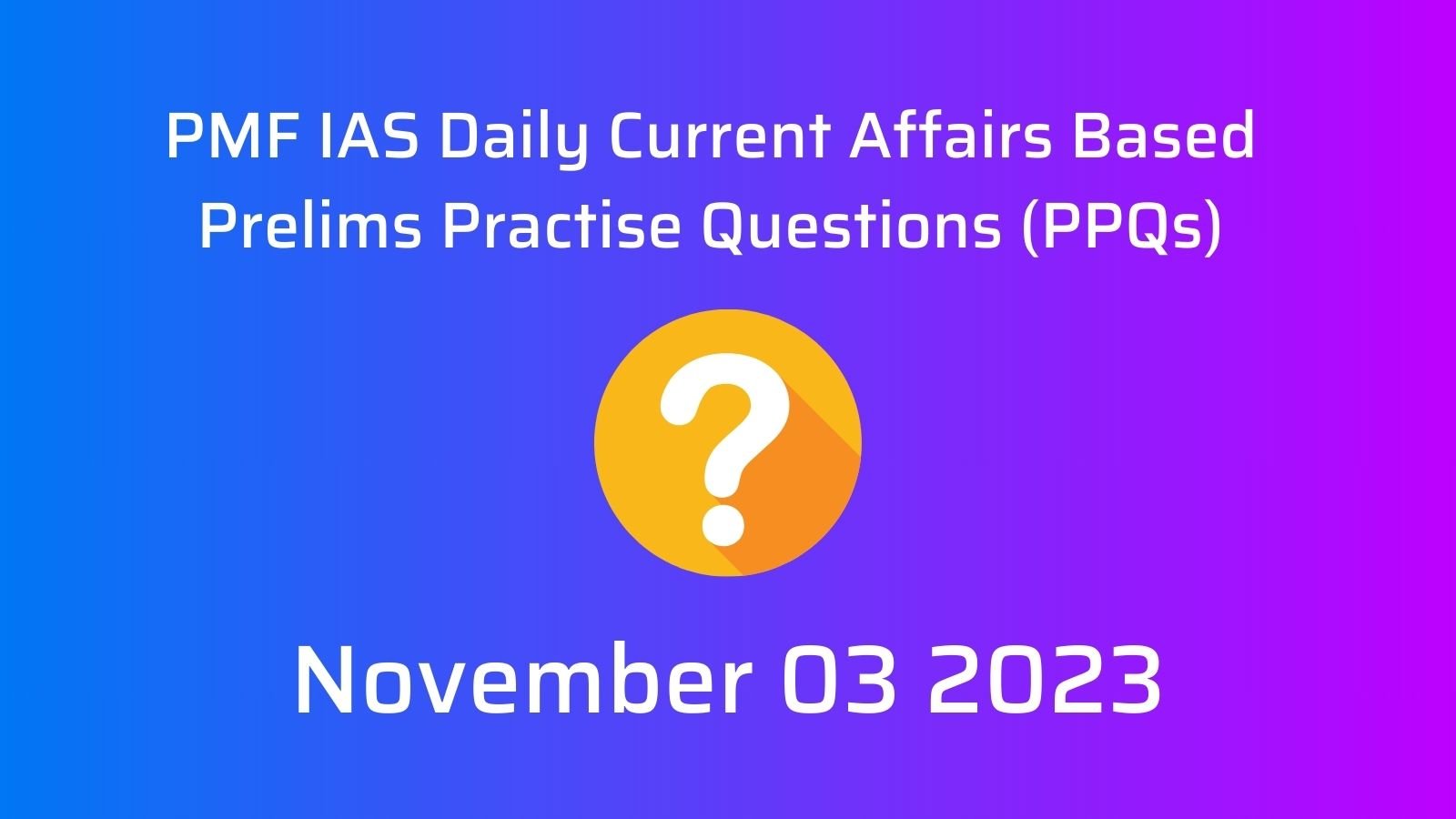
Daily Prelims Practise Questions (PPQs) – November 03 2023
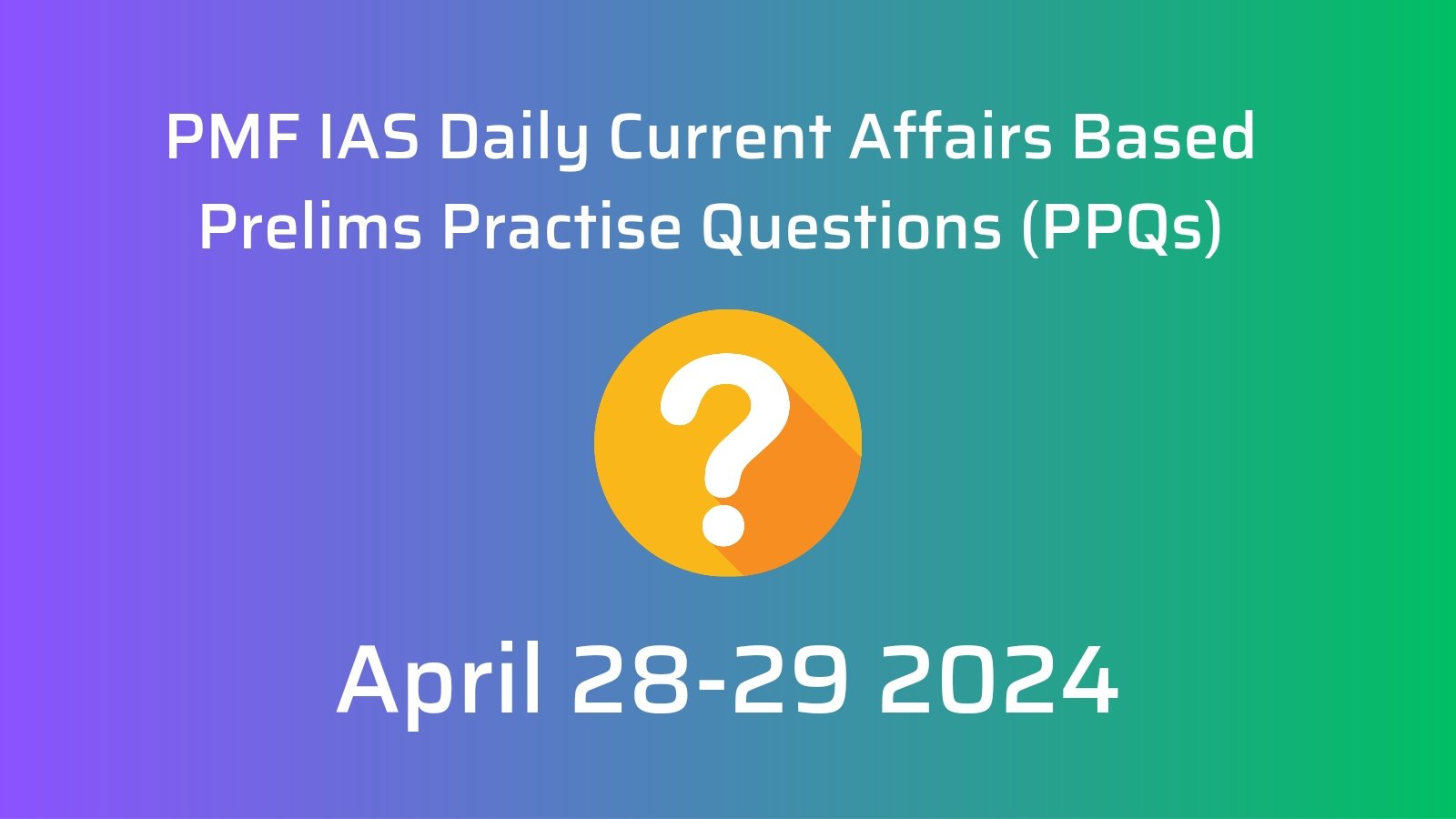
April 28-29 2024 Prelims Practice Questions (PPQs)
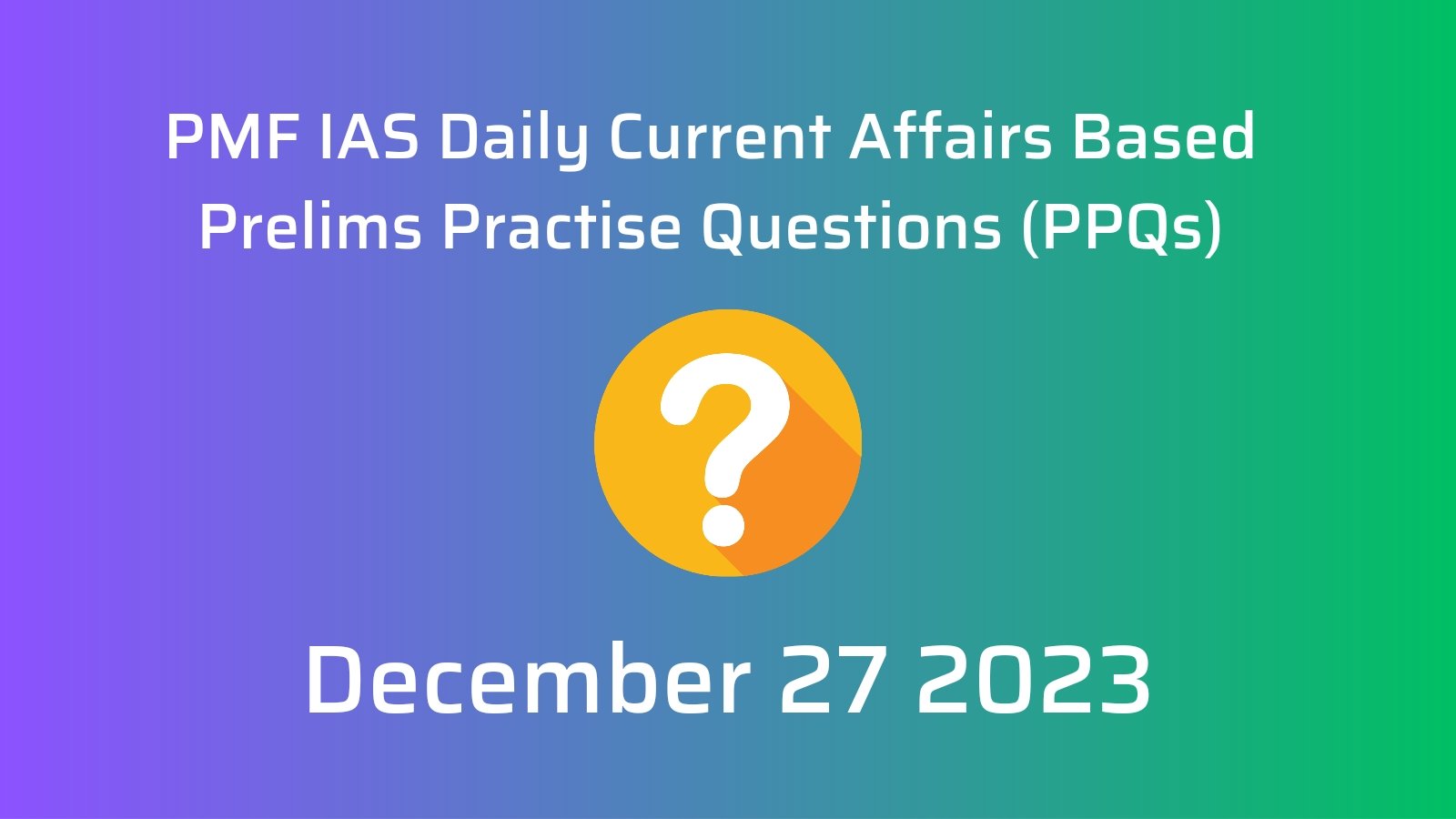
December 27 2023 Prelims Practice Questions (PPQs)
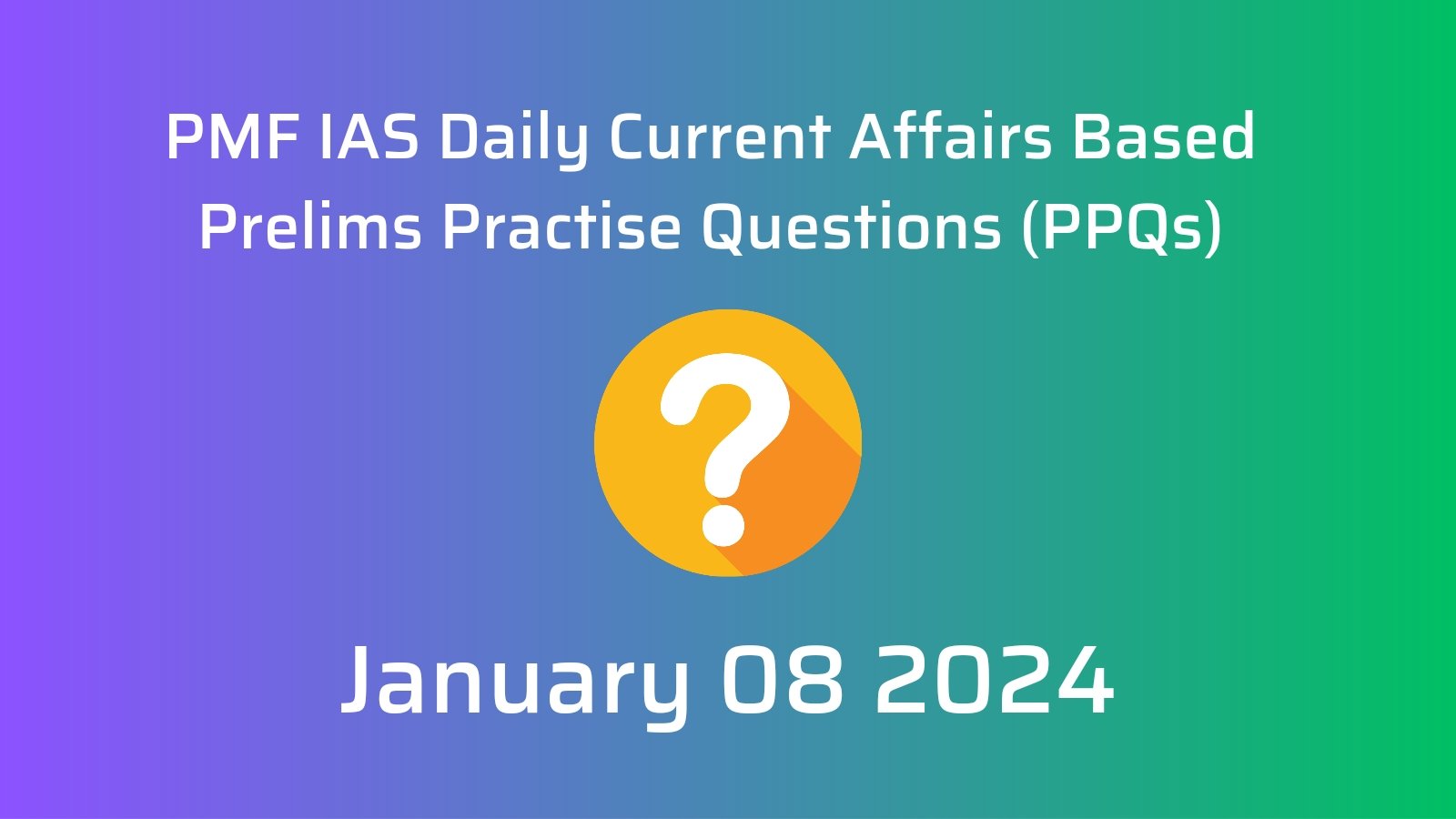
January 08 2024 Prelims Practice Questions (PPQs)
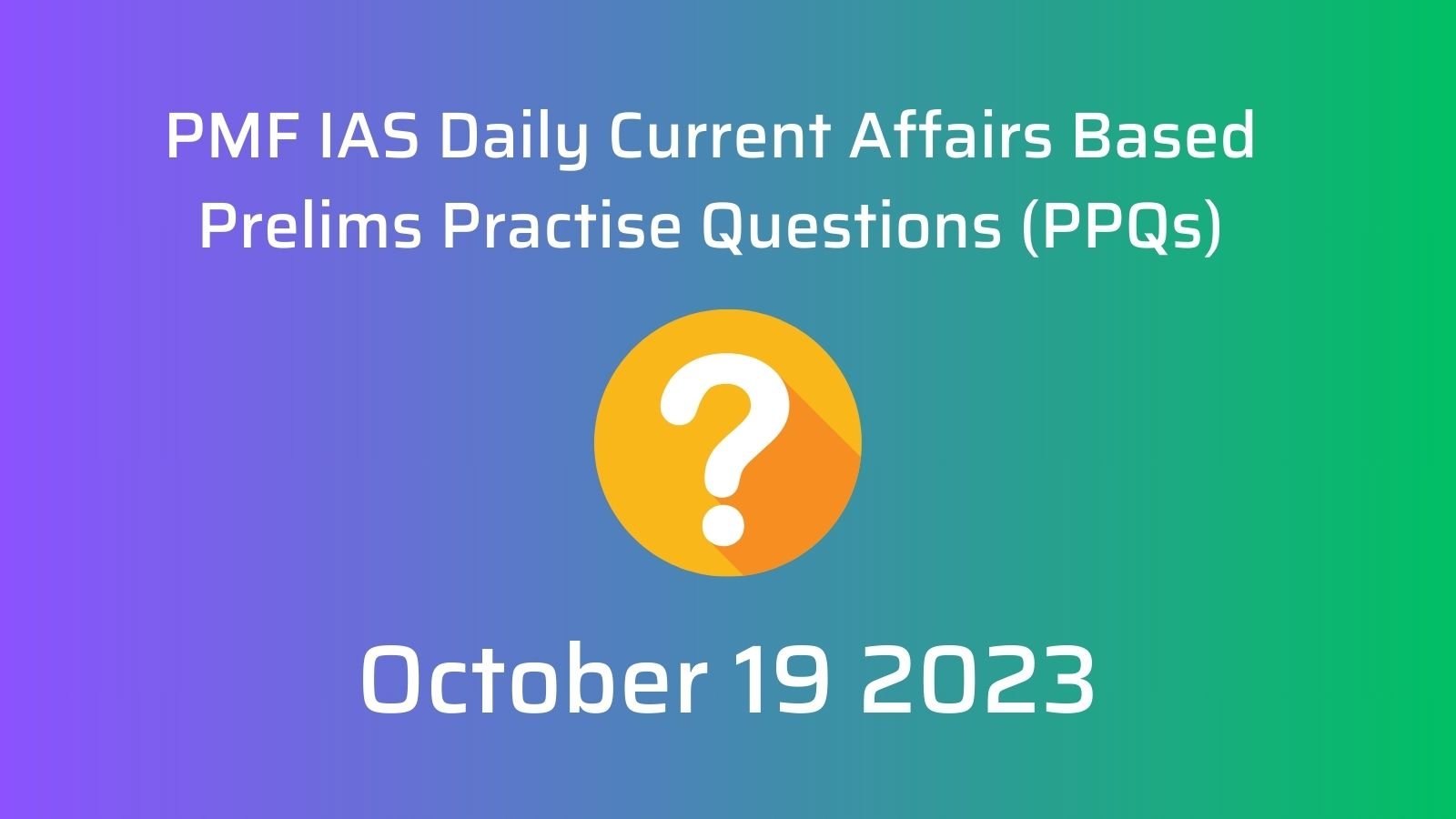
Daily Prelims Practise Questions (PPQs) – October 19 2023
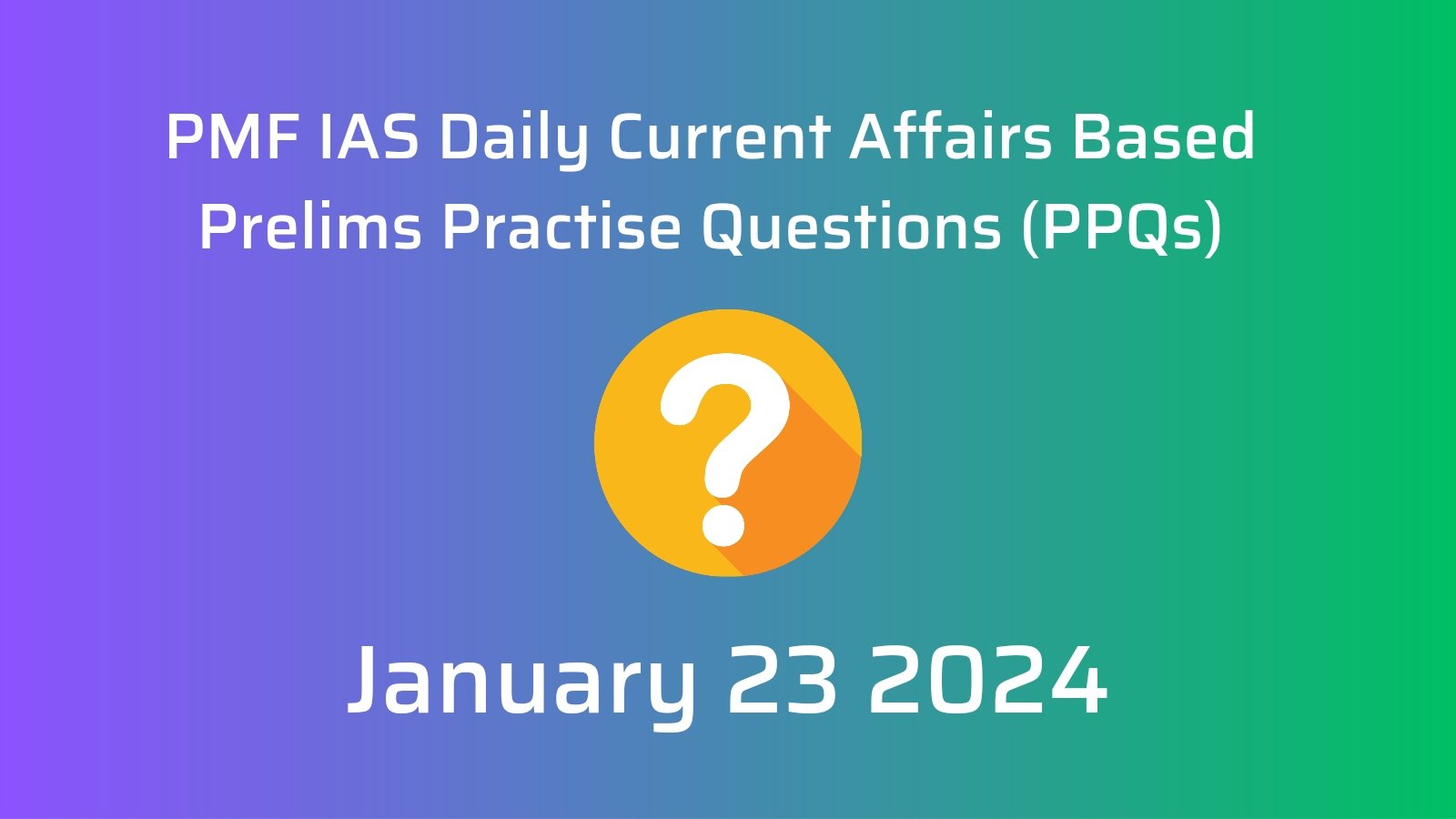
January 23 2024 Prelims Practice Questions (PPQs)
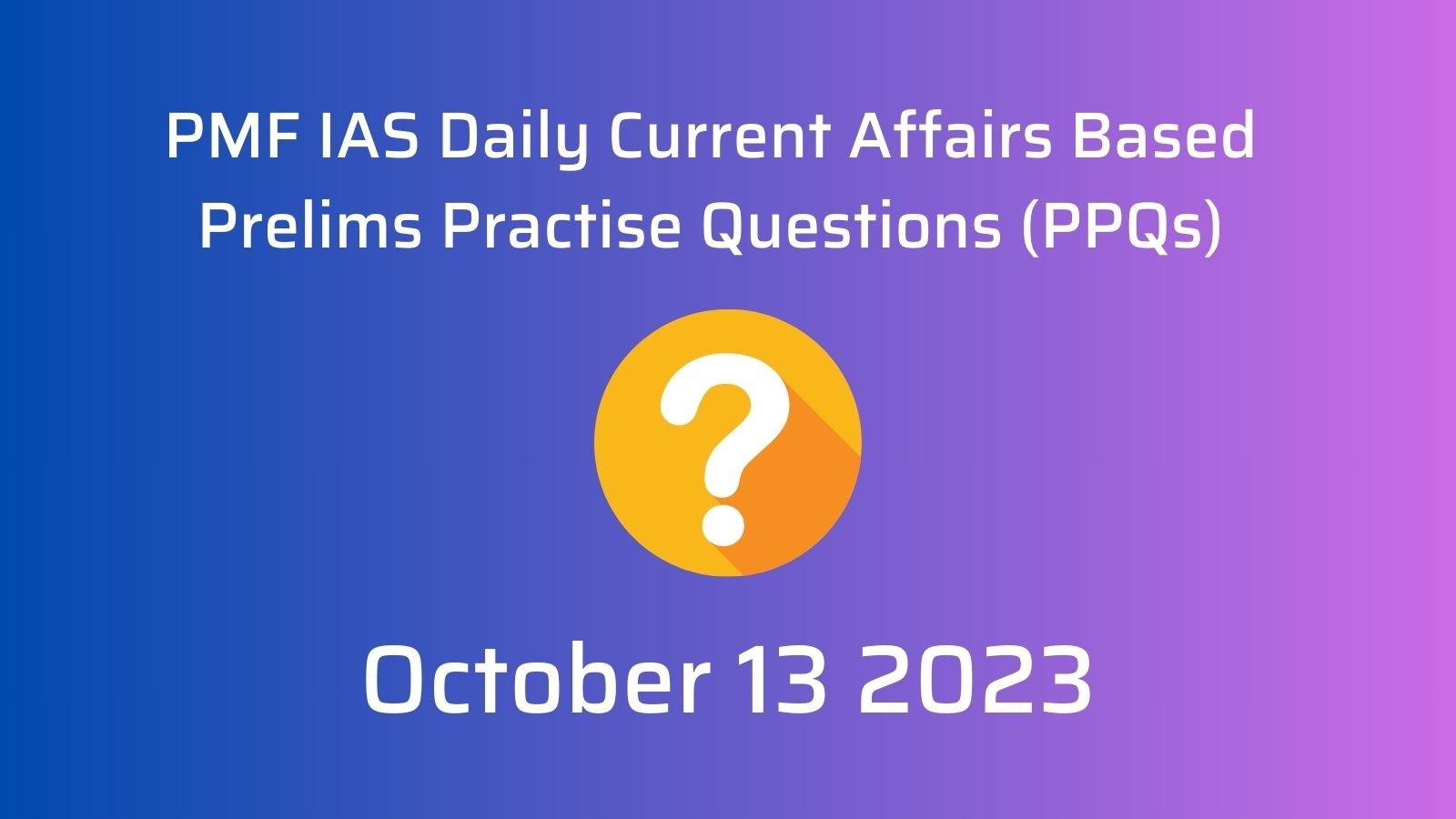
Daily Prelims Practise Questions (PPQs) – October 13 2023
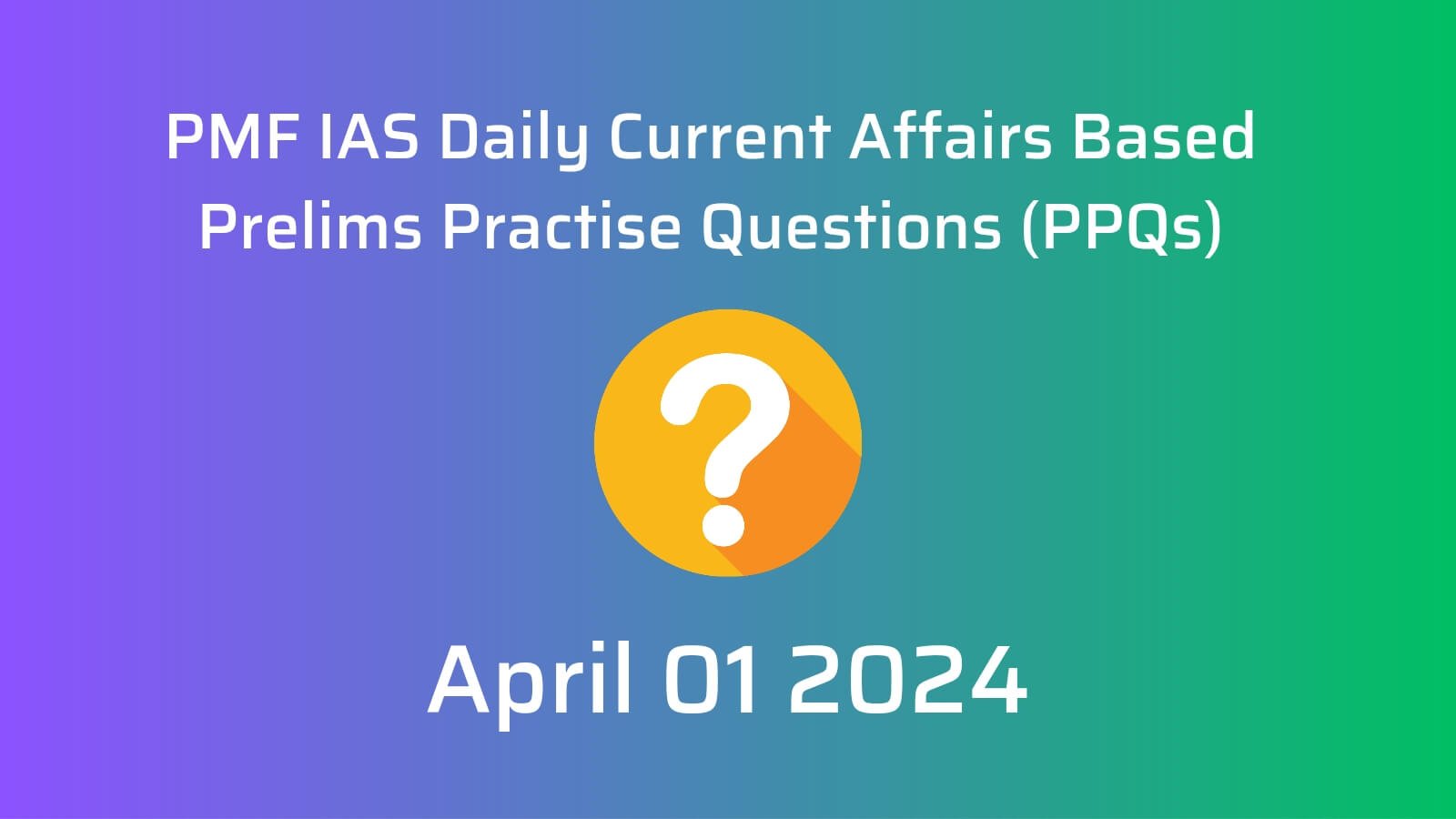




![PMF IAS Environment for UPSC 2022-23 [paperback] PMF IAS [Nov 30, 2021]…](https://pmfias.b-cdn.net/wp-content/uploads/2024/04/pmfiasenvironmentforupsc2022-23paperbackpmfiasnov302021.jpg)



